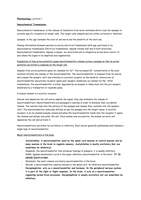Class notes
Pharmacology
- Course
- Institution
A grade notes: achieved 73% in exam! Clear and detailed notes for the entire pharmacology module! This document is filled with short and long answer exam questions, highlighting what is important for the exam. Neurochemical Transmission, life cycle of a neurotransmitter, sympathetic and parasympath...
[Show more]



